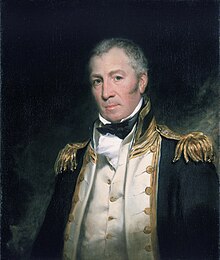Peter Heywood
Peter Heywood (born June 6, 1772 in Douglas on the Isle of Man , † February 10, 1831 in London ) was a British naval officer. He became known during the mutiny on the Bounty .
youth
Peter Heywood was born on June 6, 1772 in the Nunnery in Douglas on the Isle of Man and baptized two days later. There is no entry pertaining to him in the church records of St. Matthew's in Douglas, where the baptisms of his older siblings Mary, James and Elizabeth are recorded. However, there is an entry in the church records of St. James' in Whitehaven , where his father and family moved shortly after Heywood was born. There it says under baptisms in 1772, December 19th:
- "Peter, son of Peter John & Elizabeth Haywood, baptized privately on June 8, 1772 in Douglass, Isle of Man".
He came from a northern English noble family that can be traced back to the 11th century and comes from the town of Heywood near Manchester . His father Peter John Heywood was first second Deemster on the Isle of Man, then lawyer and moneylender in Whitehaven and later Seneschal to the Duke of Atholl . His mother, Elizabeth Spedding, came from a wealthy and respected Cumberland family. A few years later Peter was sent to Nantwich , a small town in Cheshire , and then went to St. Bee's Grammar School near Whitehaven.
The Bounty Expedition
On October 11, 1786, Peter Heywood joined the Royal Navy at the age of 14 as Captain's Servant , then a rank below the midshipmen . When it became known that an expedition under the command of Lieutenant William Bligh was to sail to the South Seas to collect breadfruit in Tahiti and bring them to Jamaica , Heywood succeeded through the mediation of Richard Betham, an acquaintance of both the Heywoods and William Blighs Father in law to hire as an acting midshipman . He started his service in August 1787. On December 23, 1787, the Bounty set sail from Spithead .
On April 28, 1789, there was a mutiny in which the 17-year-old Heywood stayed on board. As a result, he left the bounty with others on Tahiti on September 22 , while the remaining crew left the island by ship. Heywood married and later had himself tattooed according to local custom . On March 23, 1791, the frigate Pandora anchored off Tahiti, whose mission was to track down and capture the mutineers of the Bounty. Heywood volunteered aboard the same day. Nevertheless, like all the other mutineers arrested later, he was chained. On the way to his trial in Portsmouth, he survived the sinking of Pandora, malaria-infested Batavia and the long period of malnutrition. The trial of the mutineers of the Bounty took place on September 12-18, 1792 in Portsmouth on the HMS Duke. A member of the 12-member court included Albemarle Bertie , whose wife was the daughter of a fourth cousin of Peter Heywood's father.
The laws of the Royal Navy said that whoever acted neutrally in a mutiny was as guilty as the mutineers themselves, and such behavior was punishable by death . However, martial law provided for a royal pardon with which the death penalty could be lifted. As a consequence of the investigation, the court in Heywood's case unanimously approved this recommendation. Such a pardon came on October 27, 1792, and Heywood was released on the same day. Heywood Island in Antarctica is named in his honor .
literature
- Christiane Conway: Letters from the Isle of Man - The Bounty-Correspondence of Nessy and Peter Heywood . The Manx Experience, Isle of Man 2005. ISBN 1-873120-77-X
- Caroline Alexander: The Bounty. The real story of the mutiny on the Bounty . Berlin Verlag, 2004. ISBN 3-8270-0625-2
Web links
- Pitcairn Islands Study Center contains materials relating to the Mutiny on the Bounty
- Bounty project Berlin, children discover the bounty
| personal data | |
|---|---|
| SURNAME | Heywood, Peter |
| BRIEF DESCRIPTION | British naval officer |
| DATE OF BIRTH | June 6, 1772 |
| PLACE OF BIRTH | Douglas on the Isle of Man |
| DATE OF DEATH | February 10, 1831 |
| Place of death | London |
